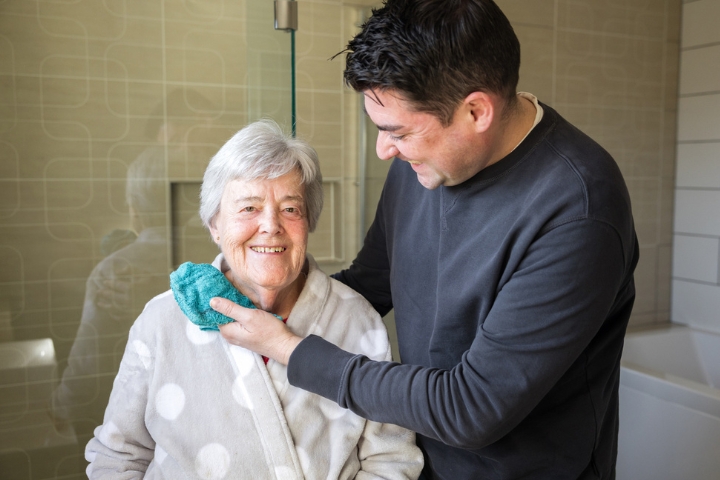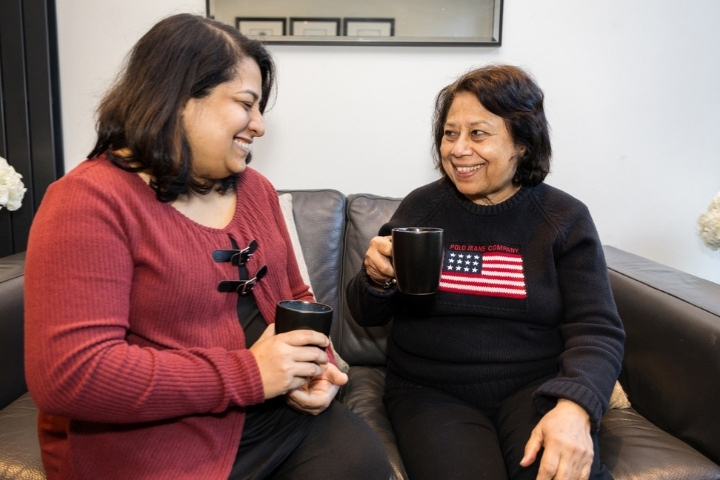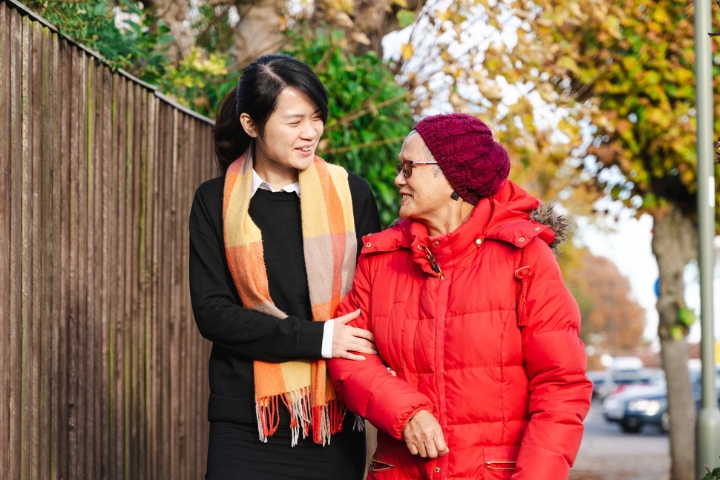When it comes to long-term care, families often face a deeply personal decision: live in care or care home? There’s no single right answer – only the right choice for your loved one’s unique needs, preferences and priorities.
At Radfield Home Care, we’ve supported families through every stage of this decision. And while both options provide safety and support, there are meaningful differences in lifestyle, independence and emotional well being that are important to understand. In this guide, we compare live in care vs care homes across key areas: quality of life, cost, and emotional impact.
Our goal is not to criticise any particular type of care, but to highlight why many families today are turning to personalised care at home – not just because it’s what’s needed, but because it’s what’s wanted.

Lifestyle and independence: Home is where life happens
One of the most striking differences between residential vs home care is lifestyle. Care homes offer structured environments with timetabled routines, shared spaces and communal activities. While this suits some people, it can also mean giving up everyday freedoms – like deciding when to eat breakfast, going out when you feel like it, or keeping your own pet.
Staying in Control, Staying at Home
With 24/7 care at home, life continues on your terms. The daily rhythm is yours, and support fits around it. Whether it’s gardening, watching a favourite show, or attending a local club, everything is designed to preserve routines – not replace them.
At Radfield, we believe that independent living with support is more than a care option – it’s a way of helping people stay connected to the things that matter most. Familiar surroundings, neighbours, local places, and even smells and sounds – all play a role in comfort, identity and well being.
“Our live in care service is designed to help individuals maintain their independence while enjoying the comfort and security of their own home. We focus on creating a safe, supportive environment where clients can live with dignity, make their own choices, and continue to enjoy the routines and surroundings they know and love. It’s about more than care – it’s about empowering people to live life on their terms,” says one of our local care managers.

Personalised attention: One-to-one, every day
In care homes, staff are responsible for multiple residents at once which is another key difference in how care is delivered. Despite best efforts, it’s difficult to provide deeply personalised care when one person is supporting several individuals with complex needs. This can sometimes lead to delays or impersonal routines.
The Advantage of a Small, Consistent Care Team
With live in care, support typically comes from a small, consistent team; usually two Care Professionals working on a rotation. Some families also require couple care, depending on individual needs. This approach allows strong, trusting relationships to form, while ensuring continuity of care over time.
But it’s not just the Care Professionals who make a difference. Behind them is Radfield’s fully managed service; an experienced office team that provides wraparound support. From medication ordering and referrals to external health professionals, to pastoral guidance and practical help for family members, we’re always there in the background making sure care is coordinated, safe, and stress-free.
This structure means care is not only personalised but proactive. Care Professionals can focus on the individual, noticing small changes, adapting routines sensitively, and building deep understanding over time. Whether it’s knowing how someone takes their tea, which jumper they wear on colder days, or what music lifts their mood; these little things matter. They create comfort, safety, and dignity.
“It’s the little things that show someone they’re known and valued. That’s exactly what our Be There movement is all about; being present in the moments that mean the most.” shares one Radfield Care Professional.
And with regular updates and ongoing contact, families feel informed and involved; without the burden of managing care themselves. Nothing gets lost in handovers or shift changes. It’s care that works like a team, but feels like family.
Emotional well being and mental health: The home advantage
Emotional well being in home care often looks different from the support available in residential care. For many people, a move into a care home is not just a change in address – it’s a profound loss of familiarity, autonomy and control. This can impact mental health and contribute to feelings of isolation, confusion or sadness.
Care That Supports the Whole Person
With live in care, emotional and mental wellbeing are woven into the support provided. There’s time for conversation, companionship, shared meals, and meaningful moments. Our Care Professionals aren’t just there to deliver tasks; they’re there to build connection.
Home is a therapeutic environment in its own right. From photos on the walls to the view from the kitchen window, staying at home helps preserve identity and memory; especially important for those living with dementia or cognitive changes.
There’s also greater scope for quality of life care comparisons. People receiving care at home often maintain a broader range of personal and social activities, which can positively influence wellbeing and even slow functional decline.

Home care vs nursing homes: understanding the key differences
Along with care home options, many families also compare home care with nursing homes. While both provide support, the type and delivery of care are very different.
A nursing home is a residential facility that offers 24-hour care from registered nurses alongside care staff. It is often chosen for people with complex health needs that require regular clinical supervision.
Home care, including live in care, provides personalised one-to-one support in familiar surroundings. For many families, this helps preserve independence, routines and emotional wellbeing.
When it comes to complex care, the cost depends on the level of support required, live in care is usually charged per household; this makes it a more cost-effective option for couples who want to stay together at home.
The choice between home care, nursing homes and care homes is about more than cost; it’s about how someone wishes to live, and where they feel most comfortable.
Is live in care cheaper than a nursing home or care home?
Understandably, many families are concerned about affordability. So how does the cost of live in care compare to care homes?
A Closer Look at Costs
The cost of care homes varies widely based on location, facilities and the level of care required. Fees often include accommodation, meals and shared care services – but many additional services may come at extra cost. And for couples, care home fees are usually charged per person, making the expense considerably higher.
Live in care, on the other hand, provides one-to-one support and is typically priced per household. For couples wishing to remain together, this can offer significantly better value.
What’s more, with live in care, you’re not paying for a facility – you’re investing in personalised support that takes place within your own home.
And while financial comparisons are important, many families feel that live in care offers value beyond the numbers – in quality of life, peace of mind, and preserving what makes a house a home.
“It cost slightly more, but for Mum and our family it was priceless – she kept her garden, her dog, and her routine.” said one Radfield client.
We’re happy to talk openly and transparently about care costs and help you understand what’s possible based on your budget and needs.
What is the difference between a care home and a nursing home?
While the terms are frequently confused, there is an important difference between a care home and a nursing home. A care home provides personal care such as help with washing, dressing, meals and daily routines; a nursing home provides this too but includes 24-hour medical care from registered nurses. Nursing homes are often the right choice for people with ongoing clinical needs or complex health conditions. For those who do not require an on-site nurse, home care offers more flexibility, familiarity and independence.
Why choose live in care?
Choosing care is not just a practical decision – it’s a deeply human one. At Radfield Home Care, we believe care should support a person’s whole life, not just their physical needs. That’s why live in care is often the option that best balances safety, comfort, independence and dignity.
It’s also a future-proof choice. As needs evolve, live in care adapts – ensuring continuity and stability, and avoiding the upheaval of a move later down the line. Many families begin with companion care or short-term support, and expand over time as circumstances change.
In summary, live in care offers:
- 24/7 support in the comfort of home
- One-to-one attention from a consistent Care Professional
- Personal routines and familiar surroundings
- Greater emotional wellbeing and social connection
- Flexibility to adapt as needs change
- A cost-effective option for couples
- The ability to stay connected to the things that matter most
Choosing live in care is about prioritising what brings joy and meaning – not just managing risk.

Let’s talk about what matters most
We know this decision can feel overwhelming. But you don’t have to navigate it alone.
At Radfield Home Care, we’re here to help you explore all the options – with honesty, sensitivity and practical insight. We offer free, no-obligation care consultations, where we take the time to understand your family’s needs and help you make informed decisions that feel right.
Whether you’re planning ahead, exploring support for a loved one, or simply need someone to talk to – we’re here to listen.
Contact your local Radfield office today and let’s take the next step together.